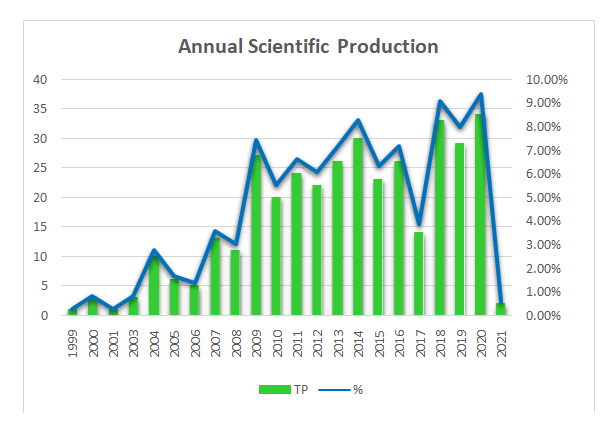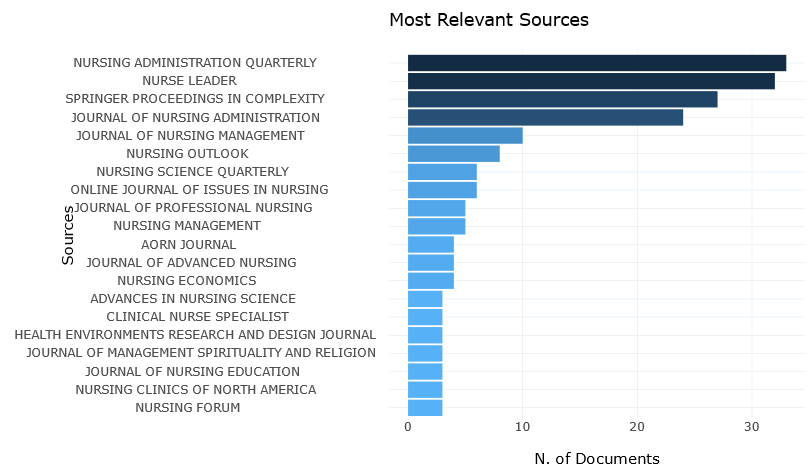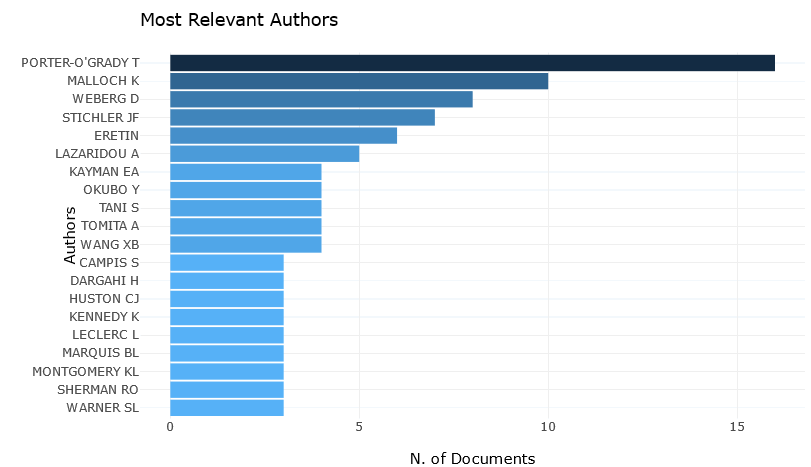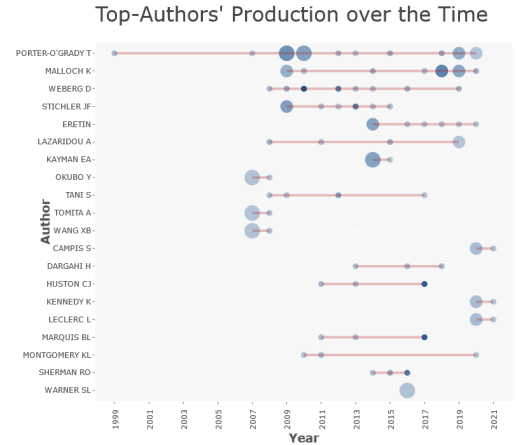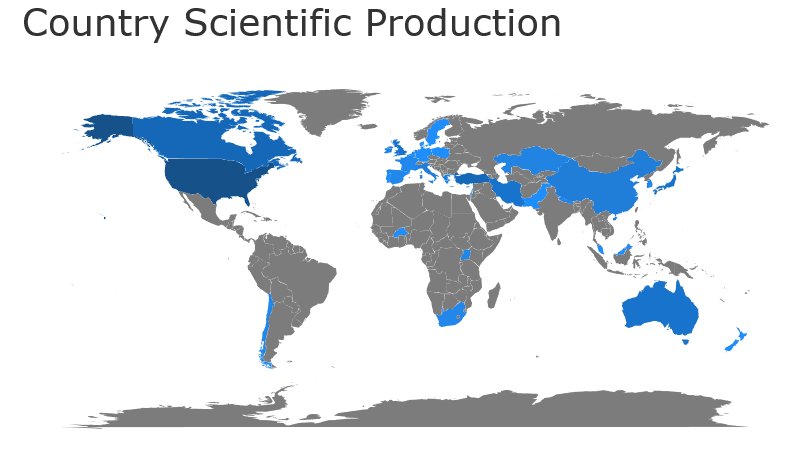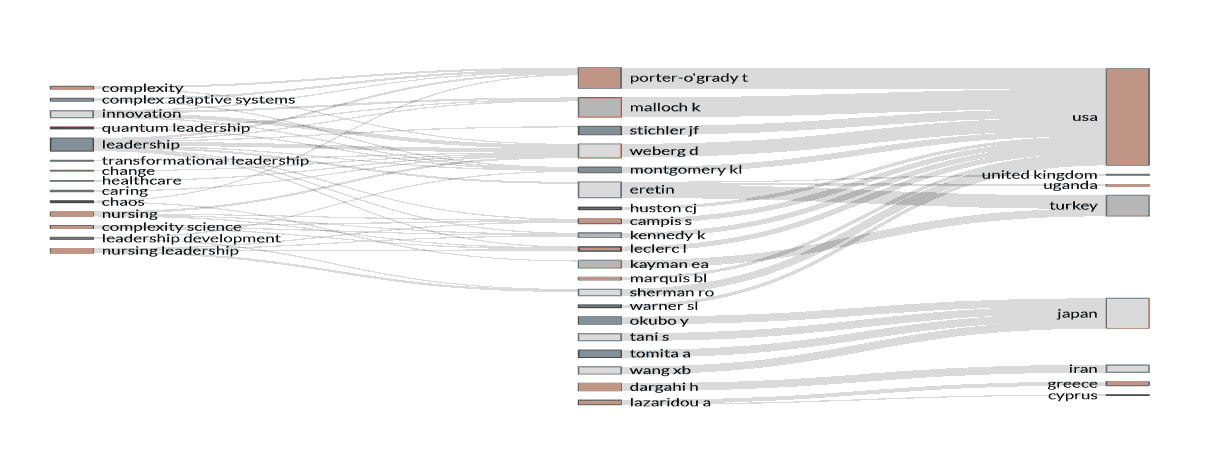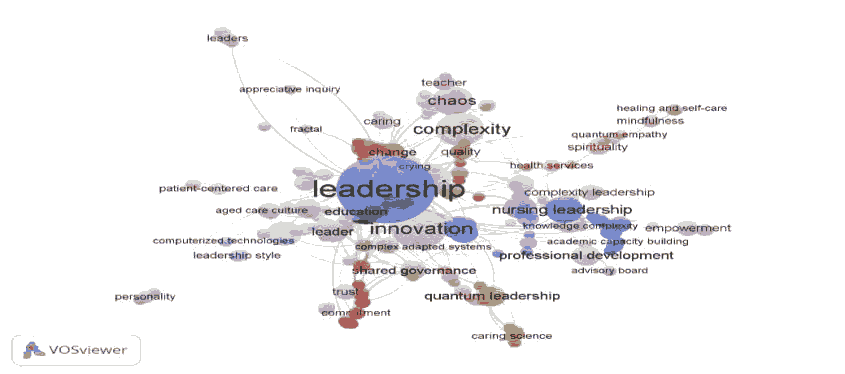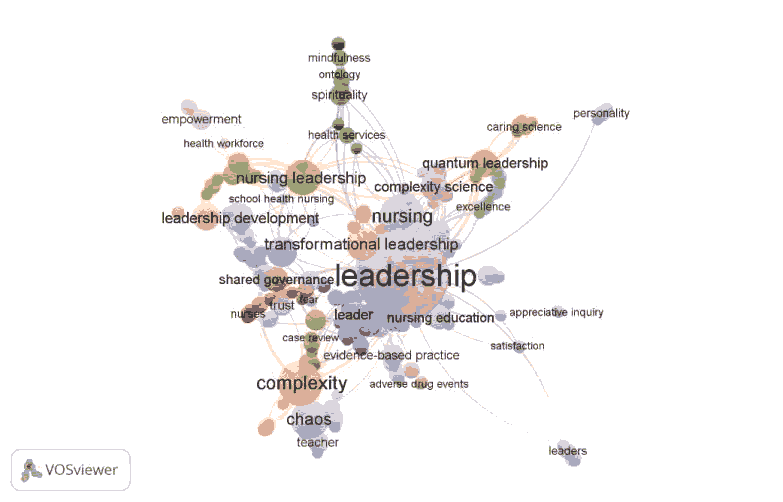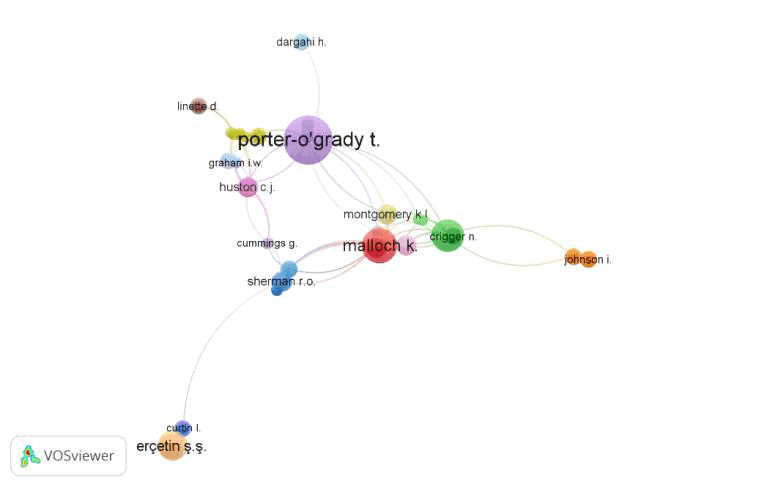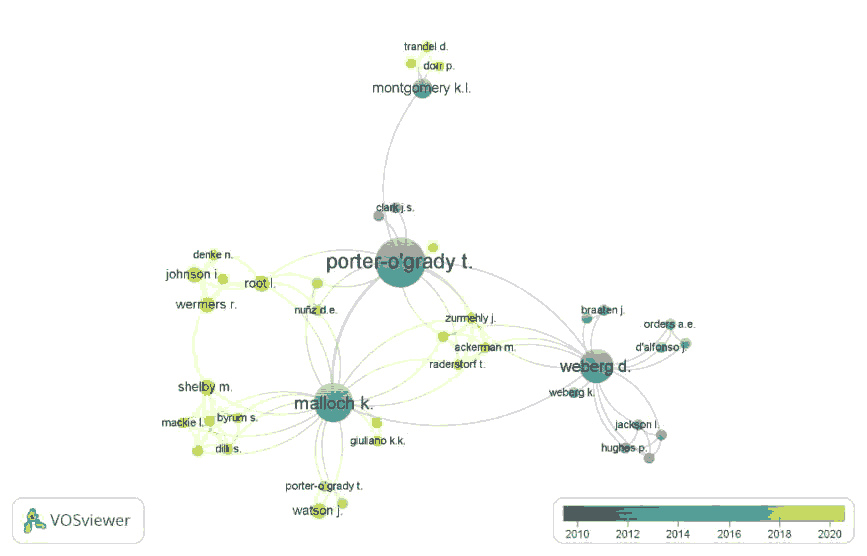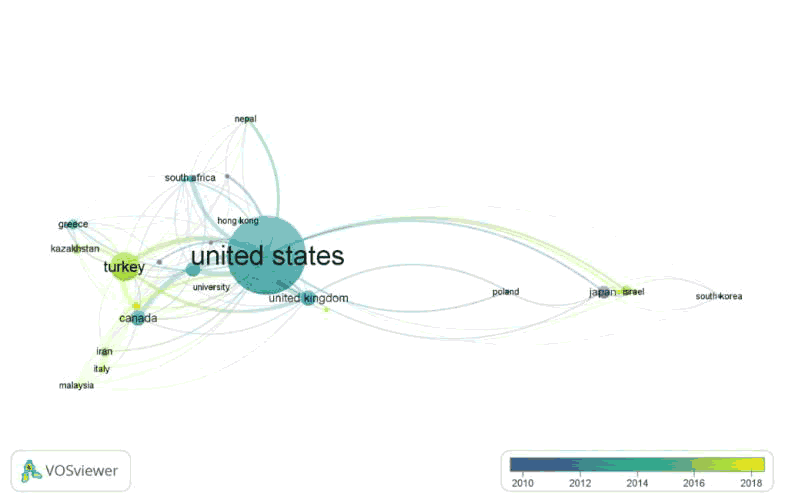Research Article: 2021 Vol: 20 Issue: 6S
Reconnoitre of Quantum Leadership Using Bibliometric Analysis: Show Up & Be Seen
Soh Wan Geok, Open University Malaysia
Mohamad Bin Bilal Ali, Universiti Teknologi Malaysia
Keywords
Quantum Leadership, Quantum Leader, Bibliometric Analysis
Abstract
The shift of the management role in this quantum era is imperative for leaders to embrace a revolutionary mindset. Hence, a bibliometric analysis study is carried out on quantum leadership. Data for analysis is obtained from Scopus database. Search string with the keywords is utilized and collected 363 valid documents for further analysis. The authors employed Microsoft Excel for basic frequency analysis, biblioshinyfor bibliometrix statistics to publications, Harzing Publish or Perish for citation metrics and analysis, and VOSviewer for data visualization purposes.Findings have presented the standard bibliometric indicators such as document type, source type, languages, subject area,current research trend, most relevant cited sources, prolific authors in quantum leadership, geographical distribution of publications in this field of study, and important keywords used.Based on the report, the study on quantum leadership will continue to increase and expected in the upward trend.This study only limited to papers that were indexed by Scopus and hence, there are possibilities of new areas to be explored. The need for study in quantum leadership genre will bring in new insights on the development of leadership at times of uncertainties to produce great leaders
Introduction
In this present quantum era, all aspects have begun changing with sky being the limit. One of the imperative qualities to run any organization is leadership. Moreover, changes from the recent pandemic demand new and continuous leadership insights. Humans are strongly affected by this modern nature and ultimately, this shift of age. The impacts observed on both leadership and management cannot be missed in this quantum era due to their significant revolution in business practices and thoughts. A shift in the management role and attributes is integral to effectively function and it is essential for leaders, particularly top managers of organizations to embrace the revolutionary mindset.
Present quantum era denotes the pinnacle of technical age that contributes to a robust and comfortable society, despite the lurking obstacles in societal development. The rapidly advancing digital age has led the present leaders to welcome and adopt cutting edge innovative ways. The old Newtonian organizational thinking that upholds market and operation by adhering low risk management, non-intricate regulation abiding certainties, equilibrium assurance, within control, and undeterred, appear unfit in this twenty first century. Since the conventional linear management system is unsuitable in this era of digital upheaval, chaos, and threats, therefore, both quantum theory and quantum leaders have come into limelight (O’Grady & Malloch, 2013). With the world being a transcendent form of consciousness, changes are inexorable as major social transformation happens. Quantum way of thinking and decentralization of leadership are of paramount in current volatile scenarios.
In comprehending the contextual framework of innovation that may be vague at times, leadership is imminent. Essentially, the present quantum leaders should identify organizational structures and strategies, expectations, and rationales to integrate costeffective innovation (Sazesh & Siadat, 2019; Turner & Baker, 2019). Hence, quantum leaders reckon the impact of energy on the quantum organization and constantly be grateful by contributing to others to accumulate positive energy in the field (Paz, Martelo & Acevedo, 2018). In attaining superior performance, leaders should create inspiring vision at par with organizational level to seek meaning and purpose, apart from profit alone. In order to raise their energetic vibration, quantum leaders indulge in their inner work and embrace their transformation.
Fundamentally, quantum leadership assesses how people behave and their decisions made in life and at organization. Change of time demands new models and approaches to address the uprising uncertainties in the environment. Despite the absence of true information integration, the cutting-edge trend must be acquired. Quantum logic needs to be adhered rather than classical logic in the organizational theory (Simbulan, 2011). Those working with systems and management systems in particular, can witness numerous parallels between physics theories, which is significant for organizations’ better understanding. In the absence of such framework, most organizations could experience the opposite effect. Quantum leadership according to (Zohar, 2016) is able to create a sustainable future for society through a leadership that uses science to transform the future of business.
Quantum organizations with dynamic energy systems have conscious observers who make reality happen. Intricacy and chaos are found in physical systems on daily basis. In line with the Newtonian or Classical paradigm, nature denotes organized simplicity, adherence to law, and ultimately, controllable. According to Watson, O’Grady, Deutsch & Malloch (2018), the Newtonian paradigm upholds boundary control and role delimitation, wherein internal dynamic leads to behavior, but not vice versa. However, the quantum paradigm in new science views nature as uncertain, intricate, and chaotic; thus encouraging leaders to innovate and think from a new stance towards becoming quantum leaders (Akmal & Ningtias, 2019; Curtin, 2011). Viewing holistically, human thinking machines are not required in organizations. The quantum paradigm highlights free flow of connections via internal dynamic that affects behavior on interactions, relationships, and forces.
The impact of uncertainty principle, which reveals only an item of two variables at one time; never both position and momentum, is enormous upon physical science and business. Since one’s paradigm dictates the action, changes are bound to happen. Instead of being a difficult science of observable phenomena, quantum physics refers to a science that is built upon relationships and logic (Curtin, 2011). The journey towards quantum leadership is above all an experiential one and unattainable when solely based on conceptual learning. It incorporates mindfulness that engages one’s heart, body, and spirituality towards awakening the wholeness experience. Leaders who successfully pursue such experience find greater purpose and meaning via consciousness and positive social impact (Laszlo, 2019).
A number of studies have assessed how scholars had fused internal estimations of significant advancement into possibility theory of quantum leadership. In identifying the similarities in quantum leadership models, an integrative model of hierarchical quantum leadership was proposed by embedding internal significance, leader esteems, vision, and good models at multiple degrees of being (Laszlo, 2019; Watson et al., 2018). The Newtonian leader encourages workers to develop individual work attributes. This is desirable for organizational members to effectively meet organizational goals. Meanwhile, a quantum leader encourages the development of both professional and selves of workers by incorporating technical, intellectual, affective, cognitive, and well-being dimensions as a whole person; not merely a tool to achieve organizational objectives (Dargahi, 2013; Kayman & Ercetin, 2011).
Quantum leadership is placing a high value on the concept involving a common, positive vision among organization members and a sense of unity or energy. Consequently, quantum leadership is the cutting-edge alternative for organizations to cultivate a broader perception and greater awareness to build a knowledgeable organization in a natural setting (Geok & Shaari, 2020). Evidently, quantum leadership is the next edge of business advantage, which can successfully inspire and engage both employees and consumers, increase authenticity, creativity, and collaboration, while meeting new expectations of the future generation that seek greater meaning and fulfilment in their life, all of which simultaneously overcoming a range of social issues.
Research on quantum leadership as new paradigm in the field of leadership style has been extensively conducted among researchers to further investigate the development of leadership in management science. Therefore, the purpose of this study is to utilize bibliometric analysis to analyse the scientific literature which published in the field of quantum leadership. Bibliometric analysis study is an attempt to quantitatively assess the academic quality of research documents and authors by statistical methods through citation rates. Comparing with the conventional literature search and reviews, bibliometric techniques able to combine with scientific surveying and mapping software tools that have the potential to classify and discover latest research trend and most relevant sources.
Main purpose for this study is to gain an overview and new insight on an emerging new paradigm of leadership from quantum science with management, the evolution of quantum leadership through a systematic, transparent, and reproducible methodology for future explorations. Hence, few research questions will be answered by the end of this study.
RQ1 : What is the current research trend in quantum leadership ?
RQ2 : Which sources are the most relevant and cited in regards to quantum leadership ?
RQ3 : Who are the most prolific authors in quantum leadership paper ?
RQ4 : Which countries are leading in the field of quantum leadership ?
RQ5 : What are the important keywords used in the study of quantum leadership ?
As quantum leadership is considered quite a new area for leadership study, authors believed that by conducting a bibliometric analysis study could provide some insightful ideas and encourage more researchers to jointly study in this leadership style and promote organization management science. Hence, authors introduce the purpose of conducting this bibliometric analysis study in this section followed by methodology used in the second section. Results will be presented in the third section to identify potential research areas for future study and give a conclusion as well as some limitations for this research.
Methodology
Bibliometric methods for scientific evaluations through quantitative methodology are showingquite obvious and straightforward outputs since it is based on simple counting. This is also why it is commonly used in the field of library and information science search, which uses statistical tools to analyse published academic research documents. Bibliometric is used to examine the knowledge structure and development of research fields based on analysis of related publications that include several descriptive statistics on citation data, analysis of authors, active sources, countries, affiliations, and keywords based on citation and frequency analysis techniques (Ahmi, Tapa & Hamzah, 2020; Lazar & Chithra, 2020; Linnenluecke, Marrone & Singh, 2020). This methodology supports the identification of research clusters and at the same time provides insights into current research interests that reveals the latest trends of emerging topics in the field of study.
Additionally, this research technique allowsnovice researchers to gain new insights through quantitative analysis based on metrics and qualitative methods, before exploring and venturing further in the particular field area. The numerical analysis of the publications produced able to provide better overview and not distorted by any cognitive biases from researchers. The use of quantitative method to examine the knowledge structure and development of quantum leadership based on analysis of related publications will reflect the evolution over time for this particular study, giving opportunities to other researchers to identify the emergence of new leadership from quantum science perspective and conduct evaluation for concerning studies.
Taken into consideration that Scopus is one of the major databases commonly used in the world of academia consisting humongous of scholarly papers apart from Web of Science, this study shall utilize this database as a base to extract documented works pertaining to quantum leadership. Scopus database has adequate supplies of publication details in the extended results that could be utilized to analyse document type, source type, language, subject area, sources, author, year, country,and keywords. As mentioned quantum leadership is new research field of leadership style which yet to be much explored, authors have decided not to restrict the research on quantum leadership studies based on the title, abstract nor keywords but covering all areas of relevant scholarly studies. As such, the flow of data search process and procedures for this bibliometric analysis are being shown in Table 1 which also covers the tools that were utilized.
| Table 1 Flow of Data Search Process and Procedures |
|||
|---|---|---|---|
| Topic: Quantum Leadership Scope & Coverage :- Database : Scopus Search Field : Quantum Leadership Timeline : 1999 – 2021 Date Extracted : 29 May 2021 Source Type : All Document Type : All |
|||
| Keywords : (ALL("quantum leadership" OR "quantum leader" OR "quantum leaders")) | |||
| Export Refine | Export in BIB format (scopus.bib) | Export in RIS Format (scopus.ris) | Export in CSV Format (scopus.csv) |
| Scopus extended refine value csv being saved to do frequency analysis | Biblioshiny web-interface for bibliometrix | POP and import external data | VOSViewer mapping approach (bibliographic map, network map) |
| Conduct basic frequency analysis | Statistics to publications | Citation metrics or citation analysis | Analysis technique (co-occurrence, co-authorship, citation, bibliographic coupling) |
| Counting technique (full counting, fractional counting) | |||
| Normalization (association strength, fictionalization, lin/log modularity) | |||
| Visualization and interpretation (network visualization, density visualization) | |||
As indicated in Table 1, this study will examine the common features through basic bibliometric results from Scopus and biblioshiny for general descriptions like document type, source type, language used, subject area, research trend, annual scientific production, active source or most relevant sources including source impact, most prolific authors and their production over time, and geographical distribution of publications; citation analysis from Harzing Publish or Perish ; VOSviewer for mapping visualization like co-occurrence keywords, co-authorship, citation, and bibliographic coupling.
Results
As bibliometric is closely related to info metrics and scientometrics, analysis is based on the identification of the corpus of literature and publication in broadest sense within a subject area. Data collected for this study viewing quantum leadership were mostly analysed in descriptive way using frequency and percentage. Whereas content analysis will be presented through mapping approach. The results shown will provide better view for future investigation and place a focus primarily on the way to create a widespread wish among decision makers to qualify and to quantify the research performed. Hence, this section will be showing up and seeing all the bibliometric results obtained from this study.
Show and See the Document, Source Type and Language
First and foremost, data obtained from Scopus database were analysed with the basic bibliometric results to identify its document types, source type, and language commonly used in the publications. There are 10 types of documentsrelated to quantum leadership which include journal article, review paper, book chapter, conference paper, book, editorial, note, letter, conference review, and short survey. As shown in Table 2, majority of the publications were articles which consists of 247 numbers (68.04%) and followed by review paper and book chapter which consist of 37 numbers (10.19%) and 36 numbers (9.92%) respectively. The rest other document types are below 5.00% of total publications and collectively made up 11.86%.
| Table 2 Document Type |
||
|---|---|---|
| Document Type | TP (N=363) | % |
| Article | 247 | 68.04% |
| Review | 37 | 10.19% |
| Book Chapter | 36 | 9.92% |
| Conference Paper | 18 | 4.96% |
| Book | 11 | 3.03% |
| Editorial | 5 | 1.38% |
| Note | 4 | 1.10% |
| Letter | 3 | 0.83% |
| Conference Review | 1 | 0.28% |
| Short Survey | 1 | 0.28% |
The conference paper which appeared under document is of different kind from those listed under source type as within document type, the conference paper is referring to papers presented in conferences and assumed to be published as full journal articles. Nevertheless, there are some conference papers which published either in conference proceeding or as book or book series within source type although the document was originated from a conference paper. Table 3 presents four types of sources where journal contributed the most with 299 publications (82.37%), second highest is conference proceeding with 36 numbers (9.92%), followed by book with 27 numbers (7.44%), whereas book series not so significant as it is below 1.00% with only 1 document.
| Table 3 Source Type |
||
|---|---|---|
| Source Type | TP (N=363) | % |
| Journal | 299 | 82.37% |
| Conference Proceeding | 36 | 9.92% |
| Book | 27 | 7.44% |
| Book Series | 1 | 0.28% |
Among languages used in the publication, English is the most common language used in 357 numbers of publication (98.35%), Turkish stands second place with 4 publications (1.10%), with remaining 2 languages French and Spanish one document each. (Table 4)
| Table 4 Languages Used In Publications |
||
|---|---|---|
| Language | TP(N=363) | % |
| English | 357 | 98.35% |
| Turkish | 4 | 1.10% |
| French | 1 | 0.28% |
| Spanish | 1 | 0.28% |
Show and See Subject Area
From subject area shown in Table 5, it is found most studies in quantum leadership were in the area of Nursing (245) representing 67.49% of total publications, second highest would be Social Sciences (45) with 12.40%, third would be in the field of Medicine (41) with 11.29%, followed by Computer Science (38) with 10.47% of total publications. Other subject areas covering quantum leadership are tabulated in Table 5 according to alphabetical order of the subject matters.
| Table 5 Subject Area |
||
|---|---|---|
| Subject Area | TP | % |
| Arts and Humanities | 4 | 1.10% |
| Business, Management and Accounting | 24 | 6.61% |
| Computer Science | 38 | 10.47% |
| Decision Sciences | 3 | 0.83% |
| Economics, Econometrics and Finance | 7 | 1.93% |
| Energy | 4 | 1.10% |
| Engineering | 5 | 1.38% |
| Environmental Science | 5 | 1.38% |
| Health Professions | 4 | 1.10% |
| Materials Science | 2 | 0.55% |
| Mathematics | 36 | 9.92% |
| Medicine | 41 | 11.29% |
| Multidisciplinary | 2 | 0.55% |
| Neuroscience | 1 | 0.28% |
| Nursing | 245 | 67.49% |
| Pharmacology, Toxicology and Pharmaceutics | 2 | 0.55% |
| Physics and Astronomy | 10 | 2.75% |
| Psychology | 3 | 0.83% |
| Social Sciences | 45 | 12.40% |
Show and See Research Trend
In viewing the research trend for quantum leadership, there is no restriction made by authors in the timeline for publication. Hence, Table 6 is a listing for all the 363 publications made since 1999 until 29 May 2021. Figure 1 is showing the annual scientific production based on the number of documents published each year which reflects the pattern of research and popularity of this study over the time. Generally, the trend is increasing with an annual growth rate of 3.36%. The performance of publication is quite consistent throughout these 22 years. Year 2020 has recorded the peak in publication followed by year 2018. Having the consideration there is a potential and increase of popularity in management science particularly in leadership from quantum science of view, there are potentials for expansion in this research area and scope of study to fields other than nursing.
| Table 6 Year of Publication |
||
|---|---|---|
| Year | TP | % |
| 2021 | 2 | 0.55% |
| 2020 | 34 | 9.37% |
| 2019 | 29 | 7.99% |
| 2018 | 33 | 9.09% |
| 2017 | 14 | 3.86% |
| 2016 | 26 | 7.16% |
| 2015 | 23 | 6.34% |
| 2014 | 30 | 8.26% |
| 2013 | 26 | 7.16% |
| 2012 | 22 | 6.06% |
| 2011 | 24 | 6.61% |
| 2010 | 20 | 5.51% |
| 2009 | 27 | 7.44% |
| 2008 | 11 | 3.03% |
| 2007 | 13 | 3.58% |
| 2006 | 5 | 1.38% |
| 2005 | 6 | 1.65% |
| 2004 | 10 | 2.75% |
| 2003 | 3 | 0.83% |
| 2001 | 1 | 0.28% |
| 2000 | 3 | 0.83% |
| 1999 | 1 | 0.28% |
| Total | 363 | 100.00% |
Show and See Relevant and Cited Sources
In the field of quantum leadership study, it is dominant in nursing field as listed in Table 7 where most relevant sources are Nursing Administration Quarterly with 33 numbers (9.09%) ranking first place, Nurse Leader with 32 numbers (8.82%) ranked second, while third place isSpringer Proceedings in Complexity that publishes interdisciplinary studies of complexity science with 27 numbers of publication (7.44%). Among the 20 top relevant sources, 17 of them are in nursing related journals, 1 transdisciplinary, 1 health environment, and 1 sourceis related in management studies. Table 8 reflected the source impact for researchers’ reference where each journal’s h_index, g_index and m_indexare shown. (Figure 2)
| Table 7 Most Relevant Sources |
||
|---|---|---|
| Source Title | TP | % |
| Nursing Administration Quarterly | 33 | 9.09% |
| Nurse Leader | 32 | 8.82% |
| Springer Proceedings In Complexity | 27 | 7.44% |
| Journal Of Nursing Administration | 24 | 6.61% |
| Journal Of Nursing Management | 10 | 2.75% |
| Nursing Outlook | 8 | 2.20% |
| Nursing Science Quarterly | 6 | 1.65% |
| Online Journal Of Issues In Nursing | 6 | 1.65% |
| Journal Of Professional Nursing | 5 | 1.38% |
| Nursing Management | 5 | 1.38% |
| AORN Journal | 4 | 1.10% |
| Journal Of Advanced Nursing | 4 | 1.10% |
| Nursing Economics | 4 | 1.10% |
| Advances In Nursing Science | 3 | 0.83% |
| Clinical Nurse Specialist | 3 | 0.83% |
| Health Environments Research And Design Journal | 3 | 0.83% |
| Journal of Management Spirituality And Religion | 3 | 0.83% |
| Journal of Nursing Education | 3 | 0.83% |
| Nursing Clinics of North America | 3 | 0.83% |
| Nursing Forum | 3 | 0.83% |
| Table 8 Source Impact |
|||||
|---|---|---|---|---|---|
| Source | h_index | g_index | m_index | TC | NP |
| Nursing Administration Quarterly | 8 | 14 | 0.57 | 244 | 33 |
| Nurse Leader | 5 | 7 | 0.26 | 78 | 32 |
| Springer Proceedings In Complexity | 2 | 4 | 0.25 | 18 | 27 |
| Journal of Nursing Administration | 10 | 16 | 0.43 | 274 | 24 |
| Journal of Nursing Management | 8 | 10 | 0.53 | 207 | 10 |
| Nursing Outlook | 3 | 4 | 0.23 | 25 | 8 |
| Nursing Science Quarterly | 2 | 5 | 0.11 | 29 | 6 |
| Online Journal of Issues In Nursing | 4 | 6 | 0.21 | 57 | 6 |
| Journal of Professional Nursing | 4 | 5 | 0.21 | 91 | 5 |
| Nursing Management | 2 | 2 | 0.25 | 6 | 5 |
| AORN Journal | 3 | 4 | 0.19 | 41 | 4 |
| Journal of Advanced Nursing | 4 | 4 | 0.24 | 114 | 4 |
| Nursing Economics | 2 | 4 | 0.12 | 29 | 4 |
| Advances In Nursing Science | 2 | 3 | 0.18 | 12 | 3 |
| Clinical Nurse Specialist | 1 | 2 | 0.09 | 5 | 3 |
| Health Environments Research And Design Journal | 2 | 2 | 0.18 | 8 | 3 |
| Journal Of Management Spirituality And Religion | 1 | 1 | 0.5 | 1 | 3 |
| Journal of Nursing Education | 2 | 3 | 0.17 | 30 | 3 |
| Nursing Clinics of North America | 2 | 3 | 0.13 | 18 | 3 |
| Nursing Forum | 2 | 3 | 0.2 | 50 | 3 |
Show and See Prolific Authors
Most prolific authors are displayed in the following Table 9 and only top 20 authors with at least 3 publications are selected. As shown in the table, Timothy Porter-O’Grady emerged as the most productive authors who has contributed 16 papers (4.41%) of total publications towards the research on quantum leadership that were indexed under Scopus database. Second placement is Kathy Malloch with 10 papers (2.75%) from total publications followed by Weberg as third and Stichler in the fourth place as productive authors. Figure 4 is showing top authors for production over the time and Table 10 is showing authors metric and collaboration frequency. Total number of authors showed 708 with author appearances of 834 times and collaboration index of 2.88 in quantum leadership study. (Figure 3, 4)
| Table 9 Most Prolific Authors |
|||
|---|---|---|---|
| Author Name | TP | % | Articles Fractionalized |
| Porter-O'Grady, T. | 16 | 4.41% | 12.18 |
| Malloch, K. | 10 | 2.75% | 5.57 |
| Weberg, D. | 8 | 2.20% | 4.43 |
| Stichler, J.F. | 7 | 1.93% | 5.25 |
| Erçetin, ?.?. | 6 | 1.65% | 2.83 |
| Lazaridou, A. | 5 | 1.38% | 3.5 |
| Kayman, E.A. | 4 | 1.10% | 3 |
| Okubo, Y. | 4 | 1.10% | 1.2 |
| Tani, S. | 4 | 1.10% | 1.87 |
| Tomita, A. | 4 | 1.10% | 1.2 |
| Campis, S. | 3 | 0.83% | 1.2 |
| Dargahi, H. | 3 | 0.83% | 1 |
| Huston, C.J. | 3 | 0.83% | 1.46 |
| Kennedy, K. | 3 | 0.83% | 1.5 |
| Leclerc, L. | 3 | 0.83% | 1 |
| Marquis, B.L. | 3 | 0.83% | 1 |
| Montgomery, K.L. | 3 | 0.83% | 1.5 |
| Sherman, R.O. | 3 | 0.83% | 1.75 |
| Wang, X.B. | 3 | 0.83% | 1 |
| Warner, S.L. | 3 | 0.83% | 3 |
| Table 10 Authors Metric and Collaboration |
|
|---|---|
| Authors Metric | Frequency |
| Authors | 708 |
| Author Appearances | 834 |
| Authors of single-authored documents | 131 |
| Authors of multi-authored documents | 577 |
| Authors Collaboration | Frequency |
| Single-authored documents | 163 |
| Documents per Author | 0.513 |
| Authors per Document | 1.95 |
| Co-Authors per Documents | 2.3 |
| Collaboration Index | 2.88 |
Show and See Citation Analysis
Harzing Publish or Perish software tool being used to obtain the citation metrics for the data collected as at 29 May 2021. Data obtained from the Scopus database is imported into POP and generate the citation metrics as shown in Table 11. The summary includes publication years, citation years, number of publications, total number of citations with their citation per year, citation per paper, and citations per author. As can be seen, a total 363 number of papers retrieved from Scopus databases covering 22 years of publication from year 1999 until 2021 on quantum leadership. Base on the Hirsch index (25) and Egghe index (41), the number of papers at a certain quality threshold and high citations can be detected.
| Table 11 Citation Metrics |
|
|---|---|
| Publication years : | 1999 – 2021 |
| Citation years : | 22 |
| Papers : | 363 |
| Citations : | 2848 |
| Cites / year : | 129.45 |
| Cites / paper : | 7.85 |
| Authors / paper : | 2.24 |
| Hirsch h-index : | 25 |
| Egghe g-index : | 41 |
| hI, norm : | 18 |
| hI, annual : | 0.82 |
| hA-index : | 7 |
Show and See Geographical Distribution of Publications
Geographically the coverage for quantum leadership study by countries is based on the affiliation institution of the author. 36 countries were identified involved in the publication on quantum leadership since 1999 until May 2021 published under Scopus. Figure 5 showing the coverage area of country scientific production in the field of quantum leadership while Table 12 shows the top countries which contributed to the publications. United States has the highest total publications with 220 documents representing 60.61% of total publications. This is followed by Turkey with 34 total number of publications having the second position covering 9.37% while remaining countries are below 20 total number of publications.
| Table 12 Countries Contributed to the Publications |
||
|---|---|---|
| Country | TP | % |
| United States | 220 | 60.61% |
| Turkey | 34 | 9.37% |
| Canada | 12 | 3.31% |
| United Kingdom | 11 | 3.03% |
| Australia | 10 | 2.75% |
| Japan | 8 | 2.20% |
| China | 5 | 1.38% |
| Greece | 5 | 1.38% |
| Iran | 4 | 1.10% |
| Kazakhstan | 4 | 1.10% |
| South Africa | 3 | 0.83% |
| Uganda | 3 | 0.83% |
| Cyprus | 2 | 0.55% |
| Hong Kong | 2 | 0.55% |
| Ireland | 2 | 0.55% |
| Israel | 2 | 0.55% |
| Italy | 2 | 0.55% |
| Netherlands | 2 | 0.55% |
| Belgium | 1 | 0.28% |
| Burkina Faso | 1 | 0.28% |
| Chile | 1 | 0.28% |
| Denmark | 1 | 0.28% |
| France | 1 | 0.28% |
| Germany | 1 | 0.28% |
| Lebanon | 1 | 0.28% |
| Malaysia | 1 | 0.28% |
| Nepal | 1 | 0.28% |
| New Zealand | 1 | 0.28% |
| Pakistan | 1 | 0.28% |
| Poland | 1 | 0.28% |
| Portugal | 1 | 0.28% |
| South Korea | 1 | 0.28% |
| Spain | 1 | 0.28% |
| Sweden | 1 | 0.28% |
| United Arab Emirates | 1 | 0.28% |
| Vietnam | 1 | 0.28% |
Show and See the Relationships
Three fields plot through biblioshiny is obtained to visualize the three items like keywords, authors and countries to show their relationships through a Sankey diagram. From the three fields plot, we can identify the relationships between three selected metadata and hence, revealed that USA has the most contributors in quantum leadership while Turkey took the second place in this field. Common keywords are listed on the left field which are being focused by the most contributed authors. (Figure 6)
Figure 6: Three Fields Plot Between Keywords – Authors – Countries
Notes : Number of items – Left field=20; Middle field=20; Right field=20
Show and See Visualization Map
Software tool VOS viewer being utilized for constructing and visualizing bibliometric networks, presenting mapping visualization for co-occurrence, co-authorship, citation, and bibliographic coupling. Counting technique like full counting and fractional counting are selected for keywords visualization for comparison purpose, whereas full counting is used for co-authorship by countries, citation by countries, citation by authors, and mapping of co-authorship. Normalization for this analysis based on strength association, fictionalization, and lin/log modularity to measure the structure of networks. Lastly, visualization and interpretation of network and density are reflected by the colour, size of the circles which determined by the weight of the item, font size, and thickness of connecting lines which represent the strength of relationships for each division. Keywords with the same colorindicating they are commonly listed in the same cluster.
As shown in the visualization maps obtained from VOSviewer on co-occurrence network based on keywords through full counting in Figure 7 that presents most common keywords are leadership, innovation, complexity, chaos, nursing leadership, quantum leadership, professional development and so on. In addition, fractional counting in Figure 8 is showing leadership, complexity nursing, chaos, nursing leadership, transformational leadership, quantum leadership, leadership development, and complexity science as the most related keywords in the publication of quantum leadership.
Figure 7: Visualization Map of Co-Occurrence Network Based on Keywords
Notes: Type of analysis=Co-occurrence; Unit of analysis=Author keywords; Counting method: Full counting
Figure 8: Visualization Map of Co-Occurrence Network Based on Keywords
Notes: Type of analysis=Co-occurrence; Unit of analysis=Author keywords; Counting method: Fractional counting
Network visualization map of the co-authorship by countries in Figure 9, 10, 11 has elucidated most contributing authors are from the United States and second position is Turkey. For citation by countries also significantly showing United States as the main cited country in quantum leadership publication. Network visualization map of the citation by author has revealed the most related authors in quantum leadership study through mapping approach.
Figure 9: Network Visualization Map of The Co-Authorship By Countries
Notes : Type of analysis=Co-authorship; Unit of analysis=Countries; Counting method=Full counting; Maximum number of countries per document=10
Figure 10: Network Visualization Map of the Citation By Countries
Notes : Type of analysis=Citation; Unit of analysis=Countries; Counting method=Full counting; Maximum number of authors per document=5
Figure 11: Network Visualization Map of the Citation By Author
Notes : Type of analysis=Citation; Unit of analysis=Authors; Counting method=Full counting; Maximum number of authors per document=5
Figure 12 is showing an overlay visualization map of the co-authorship to show developments over time. Colors indicate the impact factors of the authors where authors colored blue havean impact factor below 1, colored green have an impact factor around 2, and authors colored yellow have an impact factor of 3 or higher. Documents which are bibliographically coupled if they both cite one or more documents in common. Therefore, from the visualization map of the bibliocoupling by countries thatis illustrated in Figure 13 reflected the coupling strength of given documents among countries.
Figure 12: Overlay Visualization Map of The Co-Authorship
Notes : Type of analysis=Co-authorship; Unit of analysis=Authors; Counting method=Full counting; Maximum number of authors per document=10
Figure 13: Overlay Visualization Map of the Bibliocoupling By Countries
Notes: Type of analysis=Bibliographic coupling; Unit of analysis=Countries; Counting method=Full counting; Maximum number of countries per document=5
Conclusion
Moving into new consciousness in business organization and the well-being at work, this has attracted a gradational attention from scholars globally to explore further on the new paradigm of quantum leadership. Having the consideration that good leadership is always an integral part in management and effective direction for the organization, this study has initiated a bibliometric analysis of quantum leadership scholarly works published under Scopus for the past 22 years. A total of 363 documents have been retrieved from Scopus database. Journal article is the most common document and source type published with English is the most common medium in the publication. The most relevant source is in nursing field followed by social sciences research. Current publication in quantum leadership study has an annual growth rate of 3.36% which is still in the upward trend. The most relevant sources identified are Nursing Administration Quarterly and Nurse Leader. Timothy Porter-O’Grady and Kathy Malloch are the most prolific authors who have contributed towards the research on quantum leadership that were indexed under Scopus database. United States has the highest total publications and followed by Turkey. Important keywords used in the study of quantum leadership have also been identified in this study.
Samul (2020) has mentioned leadership is a phenomenon that is characterized by unflagging interest among scientists in the field of management and education. This article reviews the literature of quantum leadership through a unique combination of various bibliometric analyses, where authors have identified the future research directions as well as agenda in the study of quantum leadership. It is noticeable that scholarly interest in quantum leadership has been increasing these few years and showing new areas of study that can be continually explored. In this study, we demonstrated bibliometric methods used for quantifying structural indicators and explicit methodological procedures that could assist novice researchers or doctoral candidates to perform a simple bibliometric analysis paper in future. It is absolutely important to be transparent about judgments and decisions in the literature, theory, measurement, analysis, and report of data results in order to produce high quality research (Aguinis, Ramani & Alabduljader, 2018).
It is understood that in any kind of research analysis study, there are some limitations to be taken into account despite valuable insights gained. The study employed specific keywords to scholarly works that were published by Scopus database only and there are more databases to be explored like Web of Science, ProQuest, Dimension.ai, Google Scholar and so on. Hence, in this case it does not perfectly cover all available works and sources, some false results are anticipated in the analysis. Another limitation authors could identify is quantum leadership is quite a new paradigm of leadership genre to explore and therefore, most of the recent papers from new researchers within these few years might not be indexed under Scopus. This will result to the accuracy of the scientific production in the authorship and countries. In addition, quantitative method in bibliometric analysis may miss the point for a qualitative evaluation such as unnecessary citations by researchers.
As mentioned by Geok & Ali (2021), quantum leadership is not the conventional management of leadership but a new paradigm concerning the advanced organizational leadership or stewardship which provide a path through unpredictable, non-linear, and highly complex organizational natures that require the creation of a dynamic atmosphere. As such, quantum leaders conceptualized organizations as a biological or organic structure to create the passion of working towards the needs of the entire organizations rather than self-interests. The underlying foundations of quantum leadership in applying the key principles of compiling and evaluating multiple factors within an organization need to be understood. Additionally, the theoretical and practical implications of quantum leadership in organization sustainability and the relevant skills ought to be incorporated. With the environment which is at the brink of chaos, there is a need for the study in quantum leadership genre in depth which brings to the possibility of heroic paradigm of leadership. A whole new avenue would come into perspective and bring into light on uncertainties and chaotic of real environment that could definite and enable to face ongoing challenges. Quantum leadership brings in new insights on the development of leadership at times of chaos to produce more responsible and sensible leaders.
Acknowledgement
Authors hereby would like to thank the anonymous reviewers for their constructive comments and suggestions in order to improve this paper.
Funding
The authors received no financial support for the research, authorship, and/or publication of this article.
Conflicts of Interest
The authors hereby declare no potential conflict of interest concerning the authorship and/or publication for this review.
References
- Aguinis, H., Ramani, R.S., & Alabduljader, N. (2018). What you see is what you get? Enhancing methodological transparency in management research. Academy of Management Annals, 12(1), 83–110.
- Ahmi, A., Tapa, A., & Hamzah, A.H. (2020). Mapping of financial technology (FinTech) Research: A bibliometric analysis. International Journal of Advanced Science and Technology, 29(8), 379–392.
- Akmal, M., & Ningtias, R.W. (2019). Quantum leadership of teacher in improving the quality of education based on pesantren.
- Curtin, L. (2011). Quantum leadership: Succeeding in interesting times. Nurse Leader, 9(1), 35–38.
- Dargahi, H. (2013). Quantum leadership: The implication for Iranian nursing leaders. Acta Medica Iranica, 51(6), 411–417.
- Ercetin, S.S., & Kamact, M. (2011). Quantum leadership.pdf. World Applied Sciences Journal, 865–868.
- Geok, S.W., & Shaari, A. (2020). Show up & be seen : A study towards quantum leadership in quantum era. Palarch’s Journal Of Archaeology Of Egypt/Egyptology, 17(6), 411–429.
- Geok, S.W., & Ali, M.B. (2021). A journey of a thousand miles begins with a quantum step: The importance of quantum leadership to promote lifelong learning in organisations. Elementary Education Online, 20(3), 235–247.
- Laszlo, C. (2019). Strengthening humanistic management. Humanistic Management Journal, 4(1), 85–94.
- Lazar, N., & Chithra, K. (2020). Comprehensive bibliometric mapping of publication trends in the development of building sustainability assessment systems. Environment, Development and Sustainability.
- Linnenluecke, M.K., Marrone, M., & Singh, A.K. (2020). Conducting systematic literature reviews and bibliometric analyses. Australian Journal of Management, 45(2), 175–194.
- O’Grady, T.P., & Malloch, K. (2013). Quantum leadership, a textbook of new leadership. In Nursing Administration Quarterly, 28.
- Paz, R., Martelo, R.J., & Acevedo, D. (2018). Quantum leadership for co-development in private universities. International Journal of Engineering and Technology, 9(6), 4277–4287.
- Samul, J. (2020). The research topics of leadership: Bibliometric Analysis from 1923 to 2019. International Journal of Educational Leadership and Management, 8(2), 116.
- Sazesh, A., & Siadat, S.A. (2019). The relationship between quantum management and organizational agility in ministry of roads and urban development of golestan province, Iran. Dutch Journal of Finance and Management, 2(2), 2–5.
- Simbulan, M.G. (2011). Dominant logic and quantum leadership: How both Relate to Entrepreneurial Aptitude among Business and Non-Business Students. Asian Journal of Business and Governance, 1(1), 127–144.
- Turner, J.R., & Baker, R.M. (2019). Complexity theory: An overview with potential applications for the social sciences. Systems, 7(1), 4.
- Watson, J., O’Grady, P.T., Deutsch, H.S., & Malloch, K. (2018). Quantum caring leadership: Integrating Quantum Leadership With Caring Science. Nursing Science Quarterly, 31(3), 253–258.
- Zohar, D. (2016). The quantum leader: A revolution in business thinking and practice.
